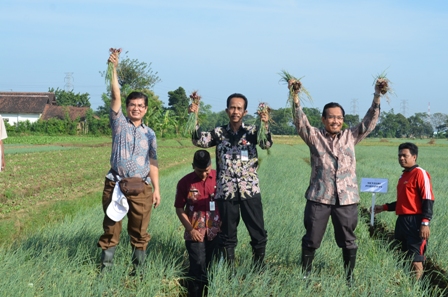Bawang Merah Harganya Mulai Turun
Onion Prices Start Down
Reporter : Gusmiati Waris
Editor : Cahyani Harzi
Translator : Dhelia Gani

Jakarta (B2B) - Kegiatan panen bawang merah di beberapa sentra produksi bawang merah di Tegal, Brebes, Pekalongan, dan Pemalang mendorong penurunan harga bawang merah lokal. Saat ini, pasokan bawang merah lokal di Pasar Induk Kramat Jati mencapai sekitar 90 ton per hari atau meningkat 100% dari pasokan sebelumnya.
"Secara bertahap diharapkan harga akan kembali normal sampai dengan mencapai pasokan sekitar 125 ton per hari. Harga bawang merah lokal di Pasar Induk Kramat Jati dan Pasar Induk Tanah Tinggi, Tangerang, pada 1 September 2013 berkisar Rp18 ribu hingga Rp20 ribu per kg," kata Direktur Jenderal Perdagangan Dalam Negeri Kementerian Perdagangan, Sri Agustina di Jakarta.
Di beberapa pasar tradisional, kata Sri Agustina, harga bawang merah juga sudah menurun di kisaran Rp30 ribu hingga Rp 33 ribu per kg atau turun 4%-22% dibanding pekan sebelumnya. Pemerintah berharap dengan mulai meningkatnya pasokan hasil panen, harga bawang merah akan segera kembali normal.
Menurutnya, faktor penyebab turunnya harga bawang merah adalah karena beberapa sentra produksi bawang merah di Tegal, Brebes, Pekalongan dan Pemalang sudah mulai panen dan menambah pasokan bawang merah ke sentra-sentra konsumsi.
Sementara, dari sisi importasi, sampai 26 Agustus 2013, realisasi impor bawang merah mencapai 5.540 ton atau 73,19% dari alokasi impor semester II 2013 sebanyak 7.569 ton.
“Diharapkan impor ini dapat membantu menstabilkan harga bawang merah, sehingga tidak memberatkan konsumen,” kata Dirjen Perdagangan Luar Negeri Kemendag, Bachrul Chairi.
Namun, Srie menambahkan, pemerintah akan terus mencermati. Jika panen bawang merah meningkat, tentunya kegiatan impor komoditas tersebut akan dihentikan.
“Saat ini juga tengah dikaji perhitungan harga wajar di tingkat eceran oleh Litbang Pertanian dan Litbang Kemendag. Nantinya hasil perhitungan ini akan dimanfaatkan sebagai harga referensi dalam penetapan kebijakan importasi yang berbasiskan harga,” jelasnya.
Jakarta (B2B) - Activity onion harvest in some onion production centers in Tegal, Brebes Pekalongan, and Pemalang encourage local onion prices decline. Currently, the supply of local onion in Kramat Jati Central Market reaches approximately 90 tons per day, an increase of 100% from the previous supply.
"Gradually the price is expecting to be back to normal until the supply reaches approximately 125 tons per day. Prices of local onion in Kramat Jati Central Market and Tanah Tinggi Central Market in Tangerang on 1 September 2013 ranged from Rp18 thousand to Rp20 thousand per kg," said Director General of Domestic Trade Ministry of Commerce, Sri Agustina in Jakarta.
In a traditional market, says Sri Agustina, onion prices also decreased to around Rp30 thousand to $ 33 thousand per kg, down 4% -22% compared to the prior week. The government hopes to begin growing onion harvest supply, then the price will soon return to normal.
According to her, the factors causing decline in onion prices is due to several centers of onion production in Tegal, Brebes Pekalongan and Pemalang already started to harvest and add onion supplies to the centers of consumption.
While, in terms of importation, until August 26, 2013, the import of onions reached 5,540 tons or 73.19% of the allocation of the second half of 2013 as imports of 7,569 tons.
"It is expected that these imports can help stabilize onion prices, so as not to burden the consumer," said Director General of Foreign Trade, Ministry of Trade, Bachrul Chairi.
However, Srie added, the government will keep a close watch. If the onion harvest increased, of course, the import of these commodities will be terminate.
"It is also being studied calculating fair prices at the retail level by the Research and Development of the Ministry of Agriculture, and the Agency for Research and Development of the Ministry of Commerce. The result of this calculation will be use as a reference price in determining the price-based importation policy, "he explained.















